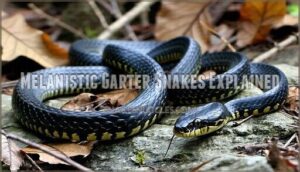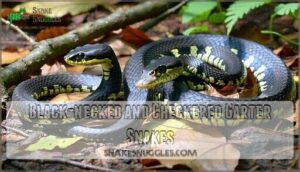This site is supported by our readers. We may earn a commission, at no cost to you, if you purchase through links.
 Yes, garter snakes can absolutely be black due to melanism—a genetic condition that cranks up melanin production.
Yes, garter snakes can absolutely be black due to melanism—a genetic condition that cranks up melanin production.
You’ll find these striking all-black specimens in roughly 1-5% of certain populations across North America.
While most garter snakes rock the classic striped patterns in greens, browns, or yellows, melanistic individuals sport solid black or charcoal coloration that can completely mask their typical markings.
These aren’t different species—they’re just wearing nature’s version of an all-black uniform while keeping the same gentle temperament and pest-control benefits.
Ontario’s Pelee Island hosts some of the highest concentrations of these natural beauties, where specific environmental factors have encouraged this dramatic color variation.
Table Of Contents
- Key Takeaways
- Garter Snake Colors and Patterns
- Can a Garter Snake Be Black?
- Melanistic Garter Snakes Explained
- Identifying Black Garter Snake Species
- Regional Distribution of Black Garter Snakes
- Why Black Coloration Occurs in Garter Snakes
- Black Garter Snakes in Their Habitat
- Distinguishing Black Garter Snakes From Similar Species
- Conservation Status of Black Garter Snakes
- Interacting Safely With Black Garter Snakes
- Frequently Asked Questions (FAQs)
- Can garter snakes be all black?
- What can be mistaken for a garter snake?
- Is a black garden snake poisonous?
- Do garter snakes have black eyes?
- What does a black-necked garter snake look like?
- What color are garter snakes?
- What is a common garter snake?
- Are black garter snakes poisonous?
- Is a black snake a garter snake?
- Where do black garter snakes live?
- Conclusion
Key Takeaways
- You’ll find melanistic garter snakes naturally occurring in wild populations – these completely black specimens result from genetic melanism that cranks up melanin production, with some areas, like Ontario’s Pelee Island, hosting up to 50% black morphs.
- Black garter snakes aren’t dangerous and offer the same pest-control benefits – they’re non-venomous, harmless to humans and pets, and excel at controlling slugs, insects, and rodents that damage your garden.
- You can identify black garter snakes by their keeled scales and slender build – despite losing their typical stripe patterns, they retain the rough-textured scales and thin body shape that distinguishes them from other black snake species.
- These dark morphs thrive in the same habitats as regular garter snakes – you’ll spot them near water sources, wetlands, woodlands, and suburban gardens where their black coloration provides superior heat absorption for basking.
Garter Snake Colors and Patterns
You’ll find garter snakes display remarkable color variation, from the classic striped pattern to solid black individuals.
These adaptable reptiles showcase everything from bright yellow racing stripes to rare melanistic morphs that appear completely dark.
Typical Coloration and Markings
From racing stripes to pitch-black beauties, garter snakes paint nature’s canvas with stunning variety.
When you first spot a garter snake, you’ll notice its distinctive three-stripe pattern running along its slender body.
These garter snake colors typically feature light stripes against darker backgrounds – think yellow, white, or cream stripes on black, brown, or olive scales.
The snake’s keeled scales give it a slightly rough texture, while those large round eyes help distinguish it from similar species.
Some individuals display checkerboard patterns instead of traditional stripe variations, and certain morph types can appear almost solid in color.
This basic template makes identifying garter snake characteristics straightforward, even when pigmentation genetics create unexpected variations.
Range of Stripe Colors
Garter snake stripes showcase remarkable diversity across species and populations.
You’ll encounter stripes ranging from bright yellow and crisp white to blue, greenish, and rich brown tones.
These stripe variations create distinct color patterns that aid in camouflage and species identification.
Even black garter snakes often retain visible striping, though pigmentation may dramatically alter traditional morph types and garter snake characteristics.
Rare and Unusual Morphs
Beyond typical striped patterns, you’ll encounter stunning rare garter snake color morphs that defy expectations.
These uncommon variations showcase nature’s genetic creativity through striking pigmentation changes.
- Albino Snakes display pink or red eyes with pale yellow stripes on white backgrounds
- Blue morphs feature stunning steel-blue coloration replacing typical dark pigments
- Orange flame varieties show vibrant orange-red hues across their entire body
- Melanistic Eastern Garter Snake specimens appear completely black with minimal markings
- Patternless morphs lack traditional stripes entirely, showing solid coloration throughout
Can a Garter Snake Be Black?
Yes, you can absolutely find black garter snakes in the wild. This isn’t some rare genetic fluke – melanistic traits occur naturally in several garter snake species.
Black garter snakes aren’t genetic accidents—they’re nature’s successful melanistic morphs thriving in the wild.
The eastern garter snake shows this black morph most commonly, with some populations displaying mainly dark coloration. Snake color genetics work differently than you might expect.
Instead of following simple inheritance patterns, garter snake color patterns involve complex interactions between multiple genes. These melanistic individuals can appear almost entirely black, though they often retain subtle striping or lighter chin scales.
Black snake identification becomes tricky because these dark morphs can look dramatically different from typical striped garter snakes. You’ll still notice their characteristic slender build and keeled scales, but the familiar three-stripe pattern might be barely visible or completely absent.
The garter snake habitat doesn’t change based on color – black morphs live alongside their colorful cousins in wetlands, gardens, and woodlands. This snake pattern variation serves important ecological functions, particularly for thermoregulation in cooler climates.
Understanding snake social behavior is vital to recognizing how these variations impact their interactions and survival.
Melanistic Garter Snakes Explained
You’ll find that melanism creates completely black garter snakes through an overproduction of dark pigments that mask their typical striped patterns.
This natural color variation occurs more frequently than you might expect, with some populations showing melanistic individuals in up to one-third of their members.
What is Melanism?
Understanding melanism starts with recognizing it’s nature’s way of cranking up melanin production to maximum levels.
This genetic phenomenon creates those striking all-black garter snakes you’ll occasionally spot in the wild, transforming typical striped patterns into solid dark beauty.
- Genetic inheritance: Melanistic traits pass from parent snakes to offspring through specific DNA sequences
- Pigmentation overdrive: Cells produce excessive melanin, overwhelming other color-producing mechanisms in snake scales
- Natural occurrence: This color morph happens spontaneously in wild populations without human intervention
How Melanism Affects Appearance
When melanism takes hold, you’ll witness a dramatic transformation.
The typical yellow or white stripes fade into subtle outlines against deep black scales, creating striking dark patterns that seem almost painted on.
These melanistic Eastern Garter Snake specimens showcase how color genetics can produce stunning black variants.
The chin and throat often retain lighter coloration, while the body displays rich ebony tones that make these snake morphs stand out dramatically from their striped relatives, with a notable display of dark patterns.
Frequency of Black Morphs in Nature
Black garter snakes aren’t just rare oddities—they’re surprisingly common in certain areas.
Melanistic rates vary dramatically by location. You’ll find less than 1% in most mainland populations, but some isolated spots like Pelee Island boast up to 50% black morphs.
Nature’s dice roll creates striking black garter snakes in some lucky populations—Pelee Island hits the jackpot with 50% dark morphs.
These melanistic Eastern Garter Snake populations thrive where black morph genetics concentrate through natural occurrence and limited gene flow.
Identifying Black Garter Snake Species
You’ll find several garter snake species can display entirely black or mostly black coloration through natural genetic variation.
The eastern garter snake is most commonly seen in melanistic forms, though other species like red-sided and California garter snakes also produce striking black morphs.
Eastern Garter Snake Variations
The Eastern Garter Snake shows incredible Pattern Variation across its range.
You’ll find completely black individuals alongside striped ones in the same population.
These Melanistic Eastern Garter Snake specimens retain their characteristic Scale Texture and body proportions.
Snake Color Morphs in this species include solid black, partial melanism, and traditional striped patterns.
Color Genetics create this diversity within Eastern Garter Snake populations naturally.
Black-necked and Checkered Garter Snakes
You’ll recognize black-necked garter snakes by their distinct collar-like dark band behind the head.
These snake morphs showcase striking black patterns against lighter backgrounds.
Checkered garter snakes display alternating dark squares along their sides, creating camouflage in shadowed habitats.
Both garter species demonstrate how color genetics produce varied black snake species across different regions, making field identification challenging without close observation.
Red-sided and California Garter Snake Morphs
Within the vast spectrum of garter snake species, red-sided and California varieties showcase fascinating Snake Color Genetics that can produce stunning black snake species.
You’ll find red-sided garter snake morphs displaying dramatic melanistic forms alongside their typical vibrant patterns. California garter snake color patterns range from classic striped to completely black morphs, particularly in coastal populations.
These garter snake morphs demonstrate how snake color morphs evolve within specific California Habitat conditions, making Morph Classification essential for proper Garter Species identification and understanding Red Sided Variations. The study of geographic range patterns helps explain the diversity of garter snake species and their adaptations to different environments.
Regional Distribution of Black Garter Snakes
Black garter snakes aren’t evenly distributed across North America—you’ll find dramatically higher concentrations in specific regions where genetic and environmental factors align perfectly.
Some locations, like Ontario’s Pelee Island, host melanistic populations reaching up to one-third of all garter snakes, making these dark morphs surprisingly common in certain ecological pockets, particularly where genetic and environmental factors contribute to their prevalence, and thus forming dramatically higher concentrations.
Areas With High Melanistic Populations
Melanistic rates vary dramatically across geographic regions, with some areas hosting remarkable concentrations of black morphs.
Population density studies reveal striking patterns where melanistic Eastern Garter Snake individuals cluster in specific locations, creating natural hotspots of these dark-colored serpents.
Researchers can access institutional access methods to study these patterns further.
- Lake Erie Basin: Up to 50% melanistic population density in western regions
- Southern Ontario: One-third of garter snakes exhibit black coloration patterns
- Great Lakes Islands: Isle Royale and surrounding areas show high melanistic rates
- Urban Environments: Cities often support equal or higher black morph frequencies
- Northern Climates: Cooler regions consistently produce more melanistic snake color morphs
Notable Locations Like Pelee Island
Pelee Island stands as nature’s melanistic showcase, where nearly one-third of Eastern Garter Snake populations display striking black coloration.
This Canadian island ecosystem creates perfect conditions for black snakes in usa studies, with water sources and isolated geographic range concentrate these Melanistic Eastern Garter Snake populations.
Snake habitats here demonstrate how regional distribution shapes snake color patterns, making Pelee Island a prime destination for observing these remarkable dark-morph garter snakes in their natural environment.
Urban Versus Rural Occurrence
You’ll find black garter snakes in both Urban Habitats and rural settings, though Rural Densities tend to be higher.
City Encounters happen in urban green spaces like parks and gardens where garter snake habitat remains intact.
Suburban Sights are common near water sources, and Snake Migration patterns show these adaptable serpents thrive wherever food and shelter exist, making garter snake types equally distributed across landscapes.
The presence of garter snakes is often influenced by their natural habitat information and adaptability to different environments, which is a key factor in their distribution.
Why Black Coloration Occurs in Garter Snakes
You’ll find that black garter snakes aren’t accidents of nature – they’re the result of specific genetic and environmental factors working together.
This dark coloration actually gives these snakes some real advantages in the wild, from better heat absorption to improved camouflage in certain habitats.
Genetic Factors Influencing Color
Black coloration in garter snakes stems from specific gene expression controlling melanin production.
You’ll find these color genetics create striking pigmentation patterns through chromatic variation.
Darkcolored morph snakes carry genes that boost melanin, contrasting sharply with albino variants lacking pigment entirely.
Snake coloration depends on multiple genetic factors working together. Garter snake color patterns reflect this complex inheritance, where certain gene combinations produce the dramatic color morphs you see in nature.
Environmental Influences on Pigmentation
Beyond genetics, your local environment plays a major role in garter snake pigmentation. Climate Impact directly affects how dark-colored morphs develop and survive in different regions.
Environmental factors influencing snake coloration include:
- Temperature patterns – Colder climates favor darker pigmentation for better heat absorption
- UV Exposure levels – Higher radiation can intensify or fade certain color patterns
- Habitat Effects from moisture – Wetland environments often support melanistic populations
- Precipitation amounts – Increased rainfall correlates with darker snake color patterns
These garter snake facts show how snake coloration adapts to local conditions, creating the striking Genetic Variation we observe across different populations. Understanding garter snake species is essential for recognizing the complex interactions between environment and pigmentation.
Evolutionary Benefits of Dark Coloration
Dark coloration offers melanistic Thamnophis sirtalis significant survival advantages.
Black snakes absorb heat faster during basking, providing vital thermal advantage for cold-blooded metabolism.
This adaptive coloration enhances camouflage in shadowy wetland environments, improving predator avoidance against birds and mammals.
Snake color patterns evolved as survival tactics, with melanistic garter snakes thriving where darker environments favor concealment over bright warning displays, utilizing their dark coloration.
Black Garter Snakes in Their Habitat
You’ll find black garter snakes thriving in the same diverse habitats as their colorful cousins, from wetlands and marshes to woodlands and even your backyard garden.
These dark-colored serpents use their black pigmentation to their advantage, basking on rocks and logs to absorb heat more efficiently than lighter-colored snakes.
Preferred Environments and Microhabitats
You’ll spot black garter snakes thriving in diverse locations where water sources and shelter options converge.
These adaptable serpents favor areas that provide both moisture and hiding spots for ideal survival. Creating suitable snake habitat products is essential for their well-being in captivity.
Black garter snakes commonly inhabit these prime locations:
- Wetland Areas – Marshes, swamps, and boggy regions offer abundant amphibian prey
- Riparian Zones – Stream banks and pond edges provide water access and dense vegetation
- Forest Habitats – Woodland clearings with fallen logs and leaf litter create perfect cover
- Garden Spaces – Suburban areas with irrigation and mulch attract these beneficial predators
Thermoregulation and Basking Behavior
You’ll notice black garter snakes maximize their dark coloration advantage through strategic basking behavior.
These snakes position themselves on sun-warmed surfaces like rocks, logs, or pavement to absorb heat efficiently. Their melanistic coloration provides superior thermal regulation compared to lighter morphs.
| Basking Surface | Heat Absorption | Duration |
|---|---|---|
| Dark rocks | Excellent | 2-4 hours |
| Metal surfaces | Superior | 1-2 hours |
| Concrete/asphalt | Good | 3-5 hours |
| Wood logs | Moderate | 4-6 hours |
Black snakes in USA populations demonstrate remarkable cold tolerance, remaining active at lower temperatures than their lighter counterparts. This thermoregulation advantage allows them earlier morning activity and extended foraging periods during cooler weather conditions.
Seasonal Changes in Color Intensity
You’ll notice garter snake coloration shifts throughout the year.
Black snakes in usa, including melanistic garter snakes, show seasonal hue variations as temperature effects influence pigmentation.
During warmer months, melanin changes can intensify darkness, while cooler periods may fade these pigmentation variations.
Snake color variations help with thermoregulation—darker tones absorb more heat during active seasons.
Snake pattern identification becomes trickier as these color shifts occur naturally across populations.
Distinguishing Black Garter Snakes From Similar Species
When you spot a black garter snake, you’ll need to look beyond just color to confirm its identity.
Several snake species can appear dark or black, making proper identification essential for your safety and understanding.
Key Identification Features
Look for keeled scales that feel rough when you run your finger backward along the garter snake’s body.
Check for large, round eyes and a slender build.
Snake patterns on melanistic garter snakes often retain faint stripe outlines or head markings despite the dark color morphs.
Scale types help distinguish them from smooth-scaled species, and body shapes remain consistently thin compared to stockier snakes, which can be identified by their melanistic color morphs.
Commonly Confused Snake Species
Black garter snakes often get mistaken for other dark snake species, creating Snake Lookalikes challenges.
You’ll encounter Species Mixups with black rat snakes, which lack garter snakes’ distinctive stripes.
Water snakes share similar habitats but have thicker bodies.
Ring-necked snakes appear darker but stay much smaller.
Pattern Confusion occurs when melanistic Common Garter Snake morphs lose their typical markings, making Color Variations and Morph Similarities harder to distinguish from completely different species.
Tools for Accurate Identification
You’ll need the right gear to nail down proper snake identification. Field guides with detailed photos help distinguish garter snake patterns from similar species like ribbon snakes or milk snakes.
A magnifying glass reveals scale details, while measuring tape confirms size ranges. Smartphone apps offer instant species guides for field observations.
Color morphs become clearer with proper lighting, so carry a small flashlight during identification tips sessions. Accurate identification relies on understanding snake identification techniques, and using the right tools for proper observation.
Conservation Status of Black Garter Snakes
Black garter snakes generally maintain stable populations across North America, with most species classified as nongame wildlife under state regulations.
However, melanistic morphs face unique pressures from habitat destruction and collection for the pet trade, making their conservation status worth monitoring in localized populations.
Population Trends and Rarity
Melanistic garter snakes represent nature’s rare treasure, with black morphs comprising less than 15% of sightings in most regions.
Population decline affects over 30% of melanistic populations since the 1990s, making these Eastern Garter Snake variants increasingly uncommon.
Current population trends reveal:
- Black morphs show smaller population sizes than typical color variance patterns
- Pelee Island supports North America’s highest melanistic density
- Rural habitats maintain higher proportions than urban environments
- Genetic mutations limit transmission, sustaining natural rarity
Historical records indicate black morphs represented only 1-2% of garter snake observations, confirming their status as rare species throughout documented ranges.
Threats to Melanistic Snakes
Melanistic snakes face mounting pressures that threaten their survival.
Habitat loss fragments populations, while pollution effects contaminate water sources these snakes depend on. Climate change alters temperature patterns essential for thermoregulation. Human persecution remains problematic, as dark-colored snakes trigger unnecessary fear.
| Threat Category | Impact on Melanistic Snakes |
|---|---|
| Habitat Destruction | Wetland drainage reduces breeding sites |
| Water Pollution | Contaminates prey species and habitat |
| Road Mortality | Higher visibility increases vehicle strikes |
| Urban Development | Fragments natural corridors |
| Disease Outbreaks | Weakens already stressed populations |
Conservation Efforts and Legal Protections
Fortunately, multiple conservation programs actively protect black garter snakes through habitat preservation and species protection initiatives.
Wildlife laws in many states classify melanistic populations as special concern species, requiring permits for collection.
Environmental policy focuses on wetland restoration and buffer zones around critical habitats.
Snake legislation restricts trade of rare morphs, while conservation efforts include university research projects and citizen science programs monitoring population trends and genetic diversity.
Interacting Safely With Black Garter Snakes
Encountering a black garter snake in your yard shouldn’t cause alarm—these harmless creatures pose no threat to you, your family, or pets.
You’ll actually benefit from their presence since they control pest populations by eating slugs, insects, and small rodents that damage gardens, which is a significant advantage to having them around, as it helps maintain a healthy balance.
Are Black Garter Snakes Dangerous?
You don’t need to worry about black garter snakes posing any real threat.
These nonvenomous snakes rarely bite humans, and when they do, Snake Bite Effects are minimal—comparable to a small scratch.
Black Snake Behavior remains defensive rather than aggressive.
While garter snake venom exists, it’s harmless to humans.
Their main Defensive Mechanisms include releasing foul-smelling musk when handled.
Following basic Snake Safety Precautions like observing from a distance keeps encounters peaceful and safe.
Benefits in Gardens and Ecosystems
You’ll love having these garden helpers around your property.
Black garter snakes excel at pest control, devouring slugs, insects, and rodents that damage plants.
They maintain ecosystem balance by controlling amphibian populations while supporting wildlife food webs.
Garden snakes like these boost garden ecosystems through natural pest management.
Their ecological role as both predator and prey keeps your outdoor spaces healthy without harmful chemicals.
Understanding the Garden Snake habits can further enhance their benefits in your garden, promoting a healthy ecosystem balance.
Responsible Observation and Removal Practices
Watch black garter snakes from a respectful distance using binoculars for safe wildlife observation. If removal becomes necessary, contact wildlife professionals rather than attempting snake handling yourself.
These nonvenomous snakes prefer to flee when disturbed. Create coexistence strategies by removing attractants like dense brush piles.
Remember, garter snake identification helps distinguish them from other species, promoting better snake safety practices in your yard. Effective snake removal methods involve using safe distance tools to minimize risks during interactions.
Frequently Asked Questions (FAQs)
Can garter snakes be all black?
Like shadows dancing through tall grass, you’ll find that nature’s palette includes pure ebony serpents.
Yes, garter snakes can be completely black through melanism, a natural color morph especially common in eastern populations, sometimes comprising one-third of local snakes.
What can be mistaken for a garter snake?
You might confuse ribbon snakes, rat snakes, or racers for garter snakes.
Ribbon snakes have similar stripes but thinner bodies.
Young rat snakes can look striped.
Black racers lack the characteristic three-stripe pattern that garter snakes typically display, which is a key identifier to distinguish them from garter snakes.
Is a black garden snake poisonous?
No, a black garden snake isn’t poisonous.
You’re likely seeing a melanistic garter snake—a naturally occurring black morph.
They’re completely harmless to humans, though they’ll bite defensively and release stinky musk when handled.
Do garter snakes have black eyes?
Garter snakes typically have large, round eyes that are dark brown or black.
You’ll notice their eyes appear quite prominent against their head, and the dark coloration helps them blend with their natural surroundings.
What does a black-necked garter snake look like?
Picture yourself face-to-face with this southwestern snake species.
You’ll spot very obvious paired black neck patches on either side of the dorsal stripe at the back of the head.
Plus three light stripes on a dark-colored body with uniform orange and orange-yellow spreading throughout.
What color are garter snakes?
You’ll find garter snakes displaying highly variable colors including black, brown, gray, olive, and reddish tones.
With three light stripes that can be white, yellow, blue, or greenish on their dark background coloration.
What is a common garter snake?
The common garter snake (Thamnophis sirtalis sirtalis) is North America’s most widespread snake species.
You’ll recognize its three yellow stripes running down a dark body.
They’re harmless pest controllers living near water sources.
Are black garter snakes poisonous?
No, black garter snakes aren’t poisonous to you.
They’re non-venomous and harmless.
Their bite won’t hurt you—it’s like a minor scratch.
These melanistic morphs occur naturally, especially in eastern garter snakes.
Is a black snake a garter snake?
Not all black snakes are garter snakes.
You’ll encounter various black snake species like rat snakes, racers, and kingsnakes.
However, garter snakes can indeed be black through natural melanistic morphs, especially in eastern populations where they’re quite common.
Where do black garter snakes live?
You’ll discover black garter snakes throughout North America, from eastern Canada to Central America.
They thrive in wetlands, meadows, forests, and even your backyard, preferring areas near water sources like streams and ponds.
Conclusion
Picture discovering a sleek, obsidian serpent gliding through your garden—completely black yet unmistakably gentle.
** Absolutely. These melanistic beauties prove nature’s artistic range extends far beyond typical striped patterns.
You’ll find them across North America, from Ontario’s Pelee Island to urban parks. They’re harmless pest controllers wearing elegant black coats.
Whether you encounter one basking on warm pavement or hunting in tall grass, you’re witnessing a fascinating genetic variation that’s both rare and remarkable.
- https://www.nps.gov/articles/000/common-garter-snake.htm
- https://stevenbolgartersnakes.com/species-2/sirtalis-2/
- https://dnr.maryland.gov/wildlife/Pages/plants_wildlife/herps/Squamata.aspx?SnakeName=Common+Gartersnake
- https://www.fieldherpforum.com/forum/viewtopic.php?t=20019
- https://www.floridamuseum.ufl.edu/florida-snake-id/snake/common-gartersnake/
















